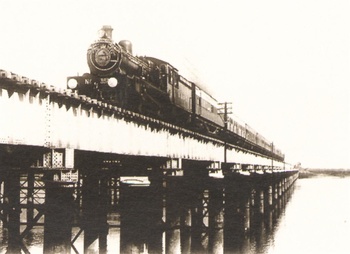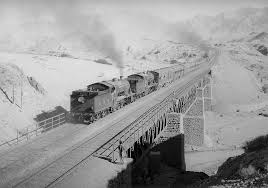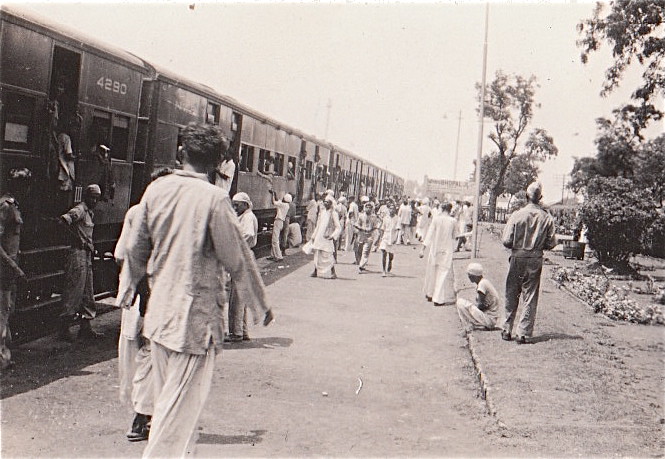trains:-http://oldphotosbombay.blogspot.in/2008/07/first-train-in-india-1853.html
1832
First proposal for a railway in India, in Madras. This remained a dream on paper.
1840s
Various proposals for railways in India, especially around Calcutta (EIR) and Bombay (GIPR).
1844
R MacDonald Stephenson’s “Report upon the Practicability and Advantages of the Introduction of Railways into British India” is published.

1845
Survey work carried out for Bombay-Kalyan line and an extension up the Malay Ghat for proposed connections to Khandwa and Pune.
May 8: Madras Railway Company is formed.
East India Railway company is formed.
May 8: Madras Railway Company is formed.
East India Railway company is formed.
1848
Governor-General Lord Dalhousie while advocating railway construction in India also says, &uot;No one can safely say whether railways in this country will earn or not”.
1849
August 1: Great Indian Peninsular Railway incorporated by an Act of Parliament.
“Old Guarantee System” providing free land and guaranteed rates of return (5%) to the private English companies willing to work on building railways. Agreed upon in March, finalized on August 17.
“Old Guarantee System” providing free land and guaranteed rates of return (5%) to the private English companies willing to work on building railways. Agreed upon in March, finalized on August 17.
1851
Locomotive Thomason is used for construction work in Roorkee, beginning on December 22.
Construction begins of an “experimental” section of track (Howrah-Rajmahal) for the proposed Calcutta-Delhi link via Mirzapur (EIR).
Construction begins of an “experimental” section of track (Howrah-Rajmahal) for the proposed Calcutta-Delhi link via Mirzapur (EIR).
1852
Construction of a line out of Bombay begins, and a locomotive, Falkland, begins shunting operations on February 23. The line is ready by November, and on the 18th of November, a trial run of the Bombay-Thane trip (35 km) is held. (Some accounts suggest another locomotive, Vulcan might have also been used for shunting operations here.)
The Madras Guaranteed Railway Company is formed.
The Madras Guaranteed Railway Company is formed.
1853

On April 16th, at 3:35pm, the first train in India leaves Bombay for Thane (see above for details). Initial scheduled services consist of two trains each way between Bombay and Thane and later Bombay and Mahim via Dadar.
A passenger train travelling from Bombay toTannah, 1855
India's first railway bridge to ...

First Train From Mumbai To Thane ...



"Railway from Calcutta to Delhi--baggage train passing the fortress of Rhotas," from the Illustrated London News, 1851;

"An Indian railway station," from the Illustrated London News, 1854;

"Opening of the Madras railway," from the Illustrated London News, 1856

"Santhan Rebellion: Affray between Railway Engineers and Santhals," Illustrated London News, 1856

"Engineer's camp, on the East Indian Railway," from the Illustrated London News, 1857
![THEN AND NOW: 1934-FIRST AIR CONDITIONED TRAIN[ Frontier Mail ] IN INDIA USED ICE BLOCKS TO COOL THE TRAIN](data:image/jpeg;base64,/9j/4AAQSkZJRgABAQAAAQABAAD/2wCEAAkGBxMTEhUTExQWFRUXGR8YGRgYGBkfHRsaGBgaGh0eHRgeHSggIB8lHR0fITIiJSkrLi4uGyAzODMtNygtLisBCgoKBQUFDgUFDisZExkrKysrKysrKysrKysrKysrKysrKysrKysrKysrKysrKysrKysrKysrKysrKysrKysrK//AABEIARkAtAMBIgACEQEDEQH/xAAcAAACAgMBAQAAAAAAAAAAAAAEBQMGAAEHAgj/xABFEAACAQIEAwUFBQQJBAIDAQABAhEAAwQSITEFQVETImFxgQYykaGxQlLB0fAUI3LhBxUzYoKSorLxU3PC0jRDJLPiFv/EABQBAQAAAAAAAAAAAAAAAAAAAAD/xAAUEQEAAAAAAAAAAAAAAAAAAAAA/9oADAMBAAIRAxEAPwDrF7ilkH+0Ukfd1+k1Wcb7Z3LeJFq3h711CVm57qhSe9oyyY1PKdPGnzYccvhP86EvJbUZrndExJB3NBrGcdulHNmwxaDlzuoGaNJgnnQZ45jLiAPat22+1qWHpB+tGdsgJE7GIjy261BcxqZiADtoSQBI5TvMeEUFX4nbvB8xdYIgwmxk7ST1+QovDWSRJuQd4hRy8ql45jCEA7NnDdCsKY8ev4UjwOJuNCi2k9M7fD9eFBbeG424v7tb28kDKDrPjyIrMNhMf+0m6uIXsi2ZrZUCe6B47kawarmMfEWjIVBsQQCRI9dxTKx7ZXFKdqlkIzZc2Zpk/wB2PKgde0F3iD2otLa7QMrKQTHdIkETsRIPnUnBOJ41LQGLsobkn3CQAJ0Gza+vOt4fGNHeAboQoUEHw8OvOaL/AKyZR3QDtKsTt4QND50EPEb/AO0IFaw6sNVbcA+OUgxVP4lgmllOUgaHKriI010iavn9dWwCXBgc1BM+m/ypJ7SXLN1e0stL7FWLrmHgObeA3oKTwvGDDv2F3+xJJsuSQLTtyJ/6bHf7p18as9ovaJdQVYaMAG5c9dDVX4hYVwUYLBHjPzNEez3E2kYS9LXVEWGLEdqg+wT99R7vUachQW/CYrYg/PfwNMbOJS8WDLBHJvSCJ6a6+NVWzehpGUA7gMDHjTnD3FaJ35GBInf0oLBhcSls9me7Gmp0nwPnWYgqAbmcZQNOmvLxmkt2ACrCdIUEHUb7778v+KJv8MGICI7SujZgYLHoVGmhAHxoNm5bxNtkvWsp7yxlDSB9pSOWopcOKX8F+6uy9oRkuuD3RzVz05B+XORrT7+pROYtLL7jcxOh18RoaHvsjn9nvBMxXNrmAYAwWHy0mdelAzwmIt3kkajZlIEg9CPn0OhEileP9m0Lh7Ra245qdCDuGBkEHoflVbxNu5gHDKwNqYGU5jbG+Uru1v8Au7rqV6G38J4yl8CCA5GbLMgg/aRvtIeo8iAZFAluXsXZJRbTlZJHZvbyxOkC4Cw8pI6VlXAVqg5/jbWIzEXL10H7oYj4RAjypZwzFML7WmkhrYZSWYkwSG1J8R8asHELpObU67zz15/Gqlx1mQ2r6DM1tiI6o+hHlMH0oHmLuMEbJGYAxmkiY0ofh/EDctq8QSNj+vrQ1niTOs5UB/vOR/4nr4Uq4XcFtmD3bayxPu9pz0jLlAHnQP7l058rRkKgjwZSSZM7EER5Gq/jLcXNNOYM+uh/WwphxBFYgL2z9SURFPl7pj1oDHWLvZaKO6IBLTr5AR86Dy1/MTqxYDWZ1jeI25Vpst1GtPs4gHo0aGgHe4CZFlYOwSY9SfnXpHuToyjwygfqKB97P8Sd1VHYi7ZJR1nRhA70eA+Gu9H8UvLctMA5A5ss7HyiguHcGuYhsy5C+gMgjwBMN58uVdP4Twy3Yti3bUAAaxzPM0HO+BcSNxSrkF17rbSdBBK8p5jqKZqkTJ22BG4M7c5B+tWL2q4aj2muZZdNQQcpOuoJHLw6gVSbOGuqxOViOXemI6Emg8+03DRbi+n9jcPQDI5B09TtrziqtjrPaCJysDKmYZSDIIIO9XXtWCw1pipENOUyP82+m+4qs4nBXEaJNydRKxHw50BPBeK9urFwFxFsfvVCKc6kx2qDzPeHI67Gm2GxRUiCSORIj8apeOS4jC7bOW5bMq0bciG5FSJBG2tP8BjVv2+0XurIW5bn+yudPFT9k+Y5UFsTH93XXTpzpxwLidoymZs2pAfQxpMeHpVQ4biRmy5pHInoN9/CnCHvKw0YTB33BGlBcHuax4aHnPlQOLwC3GkmMwy6Hnyjy1peuOvAGYBGxJWCs9JkHXx50S+NUhVXvN02MkbwSDG/jpQeTIzLcY5YEEIpB8IA30naqncwz4O4LlhHvWcxZrZQjKYJzIYGR4kcg2x3qzsLxR0ZVAAIAE/dJEN4kUtTGMMwxDQpEKC8EnRCDygk6HeaCy8L4gl60lxHlWEidD6g6g1lVfD8KKCLedV+6LjCPOBr51ugX8OwlzEWbdxrgELlnc90lehO4Nejwgc3zebPH1j5Uu9gsfmwsGJEGZ6jL/uRj60zvcZsLILrPQan5TQeBwe2BJgyNo+vOpMPasJtZtiNJCyT8aV43jyhWNtLrwCRlRgNBpExSPB+0+IuuR+zhVj7RYayPtFfPSKC6/tKj3UWfKPlFCYi4WOutVnHYvEujKptISNNGJ+J284NC8PsYmSbt9yOQRv/AOY+FAVxPCw+g30/XoPlQ1sEblR5sOfr6+NSY/hYZZIZiNZZ2PhtMbGkxwyj7K/Acv1+FBaOAcaXD3kc3FgGGGaZWYO3Pn5gV1b+t8Plzdtay7z2ix9a+fsUQis2USo005/8mpfYvBWWui7cQXMkkW9JchYEkj3ROp36UHXuJe0i3GtW7MsrkkmPfRea+BaQCRrlPqTiL9q1ba89woiiSTyHkNZqn4PBXO0N661sAKFUITpAggaABFGwihuM8WGLBtETZMJ0JmAHDbyCR6etBd7OODyFuZ46b/rxoHivB2xNspJDDVGJiSORj51UOGez62Zys0tuwYg6cpWBTb9iddRduDxFxvzoKXdvqjMjhs6tDBmJIg9Dy+IIO9R4m3cwV/tEytHduKGBS4rDNlkaHwI2Iq3cVwNwo11M9y6o0nL3tQCHJBkRMa8hVWuOzSSoVdioZZ28Nf8Amga4XHaJctRdsuO6SNVIOqOAdGUxPXenPD8WdtjGlUbAYj9nuENJsXTFxeYPK4nRht0OoPhZLcqRN1SCMynWGXkRp5jwMg0Fyw2NW4uVgQRv+pmssxbbMhBU/e36zPSfDSq/h+IA7ET5/Sl/EsO/aHEBrhZbbKVEnu6NoI8KC1X/AGhysttkJk6ww7sTBMCY+HyoE4+zfBtvlOZYKsZBV2nQkQ4ywKTYWzbxSCbuI1B7omInLIOWSJ18ulT8L4a63ltLYBsqAskMSHDGcpDLAgwAZBjXWgb2reJWQpsEToHJkeEqYI/OtURY4Aq5ow5YFiQTdI0Phl08qyg5n7E3MxNs7AsI8TDrp/herrZwcDQEeG30rmvsljct+SY2b/IRP+jPXTMdjrCHW4x8NyPQTpQQXLY3gVCUH6mh7/GbQ2S63oANvH8qFGPe4A6jswpIK+8zDTc7Lp0negax+hWtNP1/zS4O0mHJEyJA58pI2qO9ZDEM2rLqpJJynwGwoD8Ti0Ve+6qJgywGv50gxVy1nIN0DSZAzTHSOeo+NNYBmQNd+c+ZNJuI4NV2WPyO31I9aAbE2Fuulm2zuXaAFVlzaEaTpE/Q+jbhvBrmGbK6ZXUNAMiY7NVfodztzFRcD40cM6O/7y2kkI2saHVJ1XU6gHXSrFifabAYskteyXUtsQCHCQO9lBIT94WjaZjTrQLuJ4+22GIVrmfKqsrCFBLKrANmMzttXng10Z9BJGu3Tn8aG9o7Btql27byWsQBALyNgY94kSQG1oDh2MFsz7wiBJ1Gu+YTI8586C7jGjkxgTAg+sA6a1Lw7iatGdGXqG0gRvIJkTp51WsPxJWYKAZM89Niam/rC32i2yTmMiddwJKztJGsUF2HGMNb926ATurR8JNUj2s4bZV2u23Lq8SLTAhDMxO0dPOPCpb1ld4JIryllQNFI13j8Y+VBW2XMAr23EjQtsdNdSNR4jSt4DHi03Y3jNhj3HOvZPAE6bo32vQ8qf8AEDatIbdy9dLmWtDs1yATyO8mNRIAJ2O5QYywrLqQDsQeZ8IH6igcvxA23Fs5UYGDvqD4gwVbkfKnuBurcRTs6zMTrHlHPx51S+DYmSmGvaOh/wDxrp3HPsmbkCfdPI6bGn/DkZVKWMOz35zXGJJICsZGXlp1Mz8KC3YDFgEQO8dG2OmxmaaW8TsURWGaWEwdicw6kaCKrrYi4ihbtvs3jODIIIUkaxIB/Gi+G8XuL737xCT1z7DaTl6fPrQOLeMIGttTOsi5yPnrW6lwnErBQSIjQAjUDkIrdB808NuRcUnQZoPk3dPyJroaIGVW190BhOzDRo8MwNczA3rpXCcQHw6nnOb0dQxn/Hn+BoIrkDlH8v0KC4Tey3b1snci4p6ht/nTG807n60nx90W7tq7qACUbyYfnQO2Y0Fw7EPLo8kqd4A0Oo+vSNDXs4+3vnWkuP4mFcvbIPdGaZ5ExA2570FlaSCAYPUbg9aHIL2xmBJAynXmNDt1OvrVX/r+5OhI6ST+vlTJuOM6qAQpO4jLrPUnWgDx5IlRqd9P5UsTAszwvvDU5o018af4phM6d7ofDqOVLrdwm6in7StPqI+vzigK4f7Pi4FZ301HM7TtsAO60R0NRcHw96/cNnDp2uachkDu8i07Rp6mKP4DiSbQ908ipjmZ+R1okYx1vDsxBUhrZUqMrHTQxqpJ1U8yKDofsp7EWktXGvNmuuMp7pXsogwoOpMwS2xERpvSuJcPzW5MXXU+/aBX3X0dVk6gQYn1qXi3tljXC2WAQFW7RlI1B0A6jSZqDgPEixjQACR5H8dB8aCfhGN7S2GJBcSrETBKkgn+XIyKK7Q5oGpaIGu8jURr/wAVDxbBq47QZgw3C7kcz0kfOgMNhWVph2B8AfmWoHN62MQBZvAnvdxzIIbbUnWDsQaruIwcMyPZfMpIiWIUzqNQBOkiOR8qdNeP3GH+Ffn3q3xS899BBdLigKCARmUTvEiQIA29aCucR4f2i6JoF18I8eVNfZzjb3YtuxGJtjusDBuoBuGGvaKBr94ChLZCgN26tBiNRIjUHrHXx8KA4lhAQLtq4FYQwy6FGGojU0FuxTYi84uOSzKIBkbe8R6/OmGAu5hpEa/Prrvv8qrnCeIW8Tba48rdQfvraxBB07RR908xyNQ4/ELbdLlvPAAzAtoc2sj48qDpOCxC5e8SDPQHkOZNZSrhHFbTWgZDcpIJPxrKDhS71cvY7ETbKkxoy+qkXFHwZ/hVMP0pz7MXouQdpVj5AlGPork+lBart4DQkA/P4CTQmJsZ1IysZ55YH+oirSnDrIWe9mjkVX5QCa9h7VqJtKep3PpP50FQw+AuMotj3fuzvBnVVUk/Gp//APMYl+6tsLOk5R9TrVhvcXae4Mg/XOhMVi7jDK111no0deW1BUcd7P3bTsl19V6t66VLw/hWUh1VidgVkamRIO+4idOlXbBcZIsi3ctdtlIXv5HXUxm70MNAdNfOkt+3h4JNxbZ5qjMpOu2VTMeEUCq/hOznOSDytlgza9TAP650KQUJJ947+h2/XMivV9u6XsrCgyBzaDuT+pr2b4vILg06idmG4GvT6CgG4EktcUasjZgB9peYHjGo8RTbFyrBlMC4Mw8TsY6Tr5S3SkthuxxAf3Fce9B08Y5jY6cjVk47bBt23BTc6g92GE79O7PlNAH7RcVa7bRnaWAYbAaDKdgNzIPhqKUcBxmVwpMZhAPqFFDcXdwwb7JBUazo28+M6/Gl95wpUhttY1kazHx50F/N+5AKkkTJHMAaN6eHmRypvh0VlB60nwl0EBp338f5xTPAMFESY5QPCgM7NfHxr0EXr5AjX9fzoX+t7QuG0WhsgfXKBGYruTvIoq06OMysPSN+mmm1Ah4lwayrdoWcKxkhI7rHffQA+XM0szWlfRSykRDGN/LQHn6VdLioVIIBmN4jfWQZn5VVeIrilcoBmt8sqQI1PSNh8qBLiVu2LiXrejjUdGU7qRzBGhH8qsdvHLdtdvayi3orqYzWnj3SOa8welLbmHfKFeR/EdPQH9a0vwuIfCXjcyFkIC3bZOjp4cpG4PL1NBasBwq5k7iIQddWPPpBFZR/DcMHth7Jz221UgGY6EAaMNiPCsoOQ6a6fyozhDAXkB0DHIfJxl/GaCNbDRty/wCaDrnDx2lsOzhJUEyTvsQImTMiIqfLbynMzgjaRpVc4ZjpQ5ROs8v/ALALnPoWI9KIHE74lQUAPUFo8tgKDfEMWLQ095pCnn567UDw3EdpfVSSBctjczDoSDv1zT6Uv9oluNbzZySpGwQc/DXpzrDeyhLy7qy3P8L6N8DPwFAxxWKuNcEK2ZcwQQMoeCqseTEHvDxik+OS6AFLu/UtE6dYGvrNWi5ispaBqTOsbjXbzqYYIXkOcoGibXMbnMra9zUAydvEHQKZh8Y4gySAZI68oobiFxkJa05QP7yiAZH4xB08asnZWypR7QzcnWQw5QQNCPHlA3qt8XwjIdQY5SOn4xQEcHx9sobGInIYKvGtthpJjdToD+W119kfZ63duIjk9grKzBnBRiGhAh94hiYgkyCRrXMjXXv6MuC3MThVvPcNuLkoFRdTbY5WMjWDNBTfaZLT4y/lVRaW4Qij3e7oTEbSCY2+IqvjAEXZ1VVaMxjUxJAGx6TtXTcb7GWsDeW7eY3rCguyhCCSGAAJGkSQx20QUg/pNaymMNuwQQ6h2VQQLZ2iIiGABjSPWgTYSLYhWjXYTOvKJPTzp0mV0ye9Bk76TI/RpHw9AoEgiQdSRvrsQfLfpVlwbLlhAANJjrodfGgVXuAozZoYTA0OmnnNMLHDbaqAFUAeJ+k70aZrQA/UUHi1g0+6Pn+dFph4EKYJ8TE/GvKLFEKmk/GgRYu1fIAKAHTXu/HNNDPg3ufuyJYiBqvLbXTlp8IqwcRwN1lHZzI1iYkfn+UUixCPMl9RqJfXToZ/UUCayMRZlLV1rYmSoYxOxPyFZTrD4dHEteUHxJ/AVlBQnHPxjcfSvIrdzetRQW/2TeQB1Urr1tsCPUpc/wBNPr9rnJPn+VVD2Xvw0cgyN6N+6b/eD6Vc7uHbUkec0C3GWs6svUEfEUn4S2a12bfZY2mH915YfBgfjVkez6j9b9KrWPtXLVx2VM6PEgToQZnTUGfrQHWMcwtoGtl2XumWkHLpMATHPettxK4dBZRdtdfxNC4bFtdmbbplAhnfujXbkeu5oR3vn7WHQHmCGmPFidfKgMN2827geAEn5CgOK3DmClixBkyANYiPhUb4W4yswvu8CSLamI8YgAUDZuLmH7oOJ+2TMxziPPpQeOvhNfQXsfxGzYwVm37oVBrIaZA3Kzr1EVxvhvCM960uVezmWylpYDXKGOoJ90Hq1A467dt37pts9vvtpm2APOJBMbnxNB9IcSxdprTgkZTIb+DdjqNsoNfMeIxufEPeGud2YDX3WYkD0ECPCnZ9ssW1h8O7BldcuaO8ASJ18QIpPw2zmuAn3Vg/Db50FgWWAHMQPXnR9rH2bNsguO7JYAGZnWOvSosGkDUf3htrE/iDSniGMNu7bYAZdDsNTPX0oLPg+IWrisyGcsZhGokBtuehO3MHpWf1hZ27T/S35VDaYGHtmecT13Hh+YqRlkzp4UGWOMoXyZbg72UMUOUkCZnpynxpomNCe9oRv3SRpzkCKDt61KqtAG/j4eNBOvHrRPvDTXZo+YigcTgsK7l1eMxkpkEjmSCYJE8gNKacPa0pIuWs6ttlBLho0CwdjAEcpmrXY9lsPcQsgjMIBJc5TttmGx5UHPHwFjlcPw/lWU4x/s01lynfaNmUNB+RrdBx++hDEHcEg+YMGo6de2WG7PHYpByvOdOjHOP91JooD+Ct+9CzGdWSf4lMf6oNXhceGVXgtmAaB4iTr5mud2XysrDcEEeY1q68Mjs8wecrMqwYgSGEruO6w+BoCb3EGkjKi6bMZ+QivKh3iCZn/prHoXM9KEfEAaAgb9B6TQ1/HbrMiIJJ+PKgP/qEOc5uoubk7KwYDTYbGeanpRC4KzbVVJWVgaIuY+OZgx5fPageEOXtsu5QgAae6ZM68gZPWrPZ9hceWAy2YY+8X0AEd6FUyOcaTQDPjLOQiLlwldQ7vlnf3RoROnj8qqONx37xmW2tsclMmI5Tz11/UV2LDf0bWMsXbt1yYkqcgGmsATueuu1T3f6NOHcrHgZZiTHQltDzkdKDkvszxlpYsMwtyyED7bCIJ6kZoPLLGkmknEyBcDMGhtWGwDcwPCdY6Vd/ar2UGBfPZkW3AVlePfBkFYABGWeWkUkxdgOIOocTH99R8pX6UFPe500/GmGCszaLAnUwd9hHjrQmLw2Ukctwac8Jthbahj3XBzCNjrlZfTQg0DK+Qtk6DvACBH2jt8JHhNAXbIuW2U+8NVOknSSPMjveYbpUvEnLIihZUSTIJ6KPqR/iWh7LkdRGxIj1j/V/noJvZjHb2m94ag/X5a/Gn9u8skBhI3AIkeY3qrcTtlXF9dJ1I5gzqBG8HXymnFl17t9VAz5VaInePxPxU8qBq1wgEgTA260Pw/i+a5kbQOM1puTRoy7e8ImPOpwKX8R4ejCcxRpzqQT7w1kDkdJ08fOgsCuwOZTBGvP6jWrfg/au0lsHJlOkqJk67ghcp5knQ6VQeD4ztV1gXEOVwNp6jwYaj+VNsIED98BlbRuRE8weoOtBfbftJhHAZmE+KGfpWVUuIcKNlgvvgjMDB2JP5VlBzD28w2XFFogXUW4viDIn1gVXRV3/AKQuFtasYHOVNxUa0wUggZMpWIAMESdeZNUiKDa0+4XfJGUCJSdJ1ZZUkjYyMu/SkApx7PANetqTAz5ZP99Co/1haAomV7xiP1tXq2kkAQP7zHQTpqTsB+FFYwnYFiIgBefPXpUNxG07m3iB57UEnCLnZYjKWDBgVJBkE7yOuvPxrufsTju1wqSZa3+7bX7ux/ywa4K6RDcwdAOR5eMV0/8Ao14nFxkGouqGC6br7x+B/wBIoOlxWiKgxOOt2/7R0Qf3mA+tKsT7XYRdruc9Las3zAj50C/2/wCDDEWCoBLSGEbyskAdAZI06iuQ8OUvayn3lMGfvDbTlp+NdR4t7eWsrKtsqSNDcdFjxyglq5vafDrduXO1MvLMACRqdlkAk6negS4sMLhc2S1sarqNJPP4R4RUmJxly4sKpQg/ZXM07auSIG0gDnRn7WHziIElhPQ7/n6mlyqGcJ16l4mDzAiSJHnQeFZge9JB5O8ciPPaR5oKjEAzKT1kt4+XOfJjRf7DGuZBz7qsejT3tPut8a3FsDVzM7DIBpIjeeRWfFek0E+AYTEaem8EQSQd1BQyOQ60Nwy+bTXLeWUkwD0G2/MDTx0raYi0Dpmbxlj010XeIbzQ+NGLZDnN2dzMfegCJ06+EGecigMwGMlj47COlZxJwcp1VlIZSd5mDodxE+c1BbwhH/13eonLy15iveJwrNmJtvJkk5lmfID6UEfBsWBduMuTKFC8wdG8SdB3ttqcpxFT9z1b9fCgLFpZ0w52gDO0AHlEDTf4mibWFneyix1ZvzP0oGOHx9zKIuPEaQzQB0A5VutWbbAQq2o/ic/hWUCv2yti9gWuK2b9leyhPUPaQT8Wmucir1w22btjiFjUzYS8gndrRYeuyj1qhk0Hs1PhmgmN4kea94fMUMalsvDA+NBd7mKVhKSFbUARoDsA3QVG55+HMnf/AIofhV1hZVAoA1Q6Aluzcweo5bbxUwmdxPhJPwE/M0BWCw1t0udq4U5SUADSGA7uwgyfEUFwzjBtqAVMj3YYiJmQSDPOKINrnlY+cL9ZJ+Fef2Zj92fBWY/OF+VBFe4tcJhUWTtuT9ZnwmgsNj7gvFXfvb6kZQRuDHKNPPzo7HcPuFYDlSY3gCAde6BW8NwMIugJ667+lAEbKkk5y5nWFJJ8p0olcJrpbIB++4A26b01sYABZAgzqDp8OtbS7l2yj4fr/mgCsYF9gyr/AAJP+pzUGP4cTH9oTOhdyADByt5zHPpTRJY6tvzNElQFYXCMniR8SD0NBT7gAM93w1nnI316r5RUYbkD8AZOn/rB81qfExJhl1P2Rz5wNfMV4bb7R8ZiI1Og9G8jQerY8+s6Dqf5/Gm+Cuww1AB0Omg169FJA/hZOlJAsbgDXSTMQfwOnkRRuFuaZdCDyiOWWC3QyUPmh5UFltJ1+g6USttI3O3IRz8KA4fdzLqZI8NSD7rHpzB/vBhR5aeQHh+jQSXLUHukxympEWY1PzqIL00ohIoJFTz+NbrylZQVP2Yv5MfakZluJdtMuaAQVzanpodKo+Js5GZIjKxWJn3Tl39KtvD3y37VwMytbuBwVAJjUN4TlJpJ7VWwuMv5RCly4Hg/e/GgU1sVgFbAoLZ7K3AwuoY+w+sbEZT/AKln1p9kAGpM9BtVU9kr8X7Y+8Htn1GddPNY9auD2welBAFjoBXvKSNNhpM1Fir6WwS5EA7TqRPIczGteW4zay90M25H2VKhiAdZadNRFBIiGY3nxoi3Ybcysek+Z/OktzjF0jMgVF6qs7/3mn6Cl1++zHvuzeZn5bfSgtxxeEQE3Xtt4LnZ/EHKMo85pBd4oVcsiz90OgVY3Byglif8UeFLBcAG22xJ6fy8axsSZ0kTp3RHjvp9TQEX8ddbvFggPQAfX8KFYLPelzyJk+e8fKaiP66/gfrvXkz+vyEfSgla4dI0K7efht+Nef2k5s0HedTA3JA8tSvlFR/r9R+VaNsdP5D8wdeVBIr8tNIjnyj5qAPNamteZM9NJmOem6iPMCoAecgdY5Qdeux18qntNvM7Hwgjfp7rGaBzg8TBV8oEDWN2GUE6DSSP3nmHHOnaXPXy8flVYwzQdsvUnlBXWP7rd7f3WbenvDb3d7MjUaqOgmCo1+y2n8JU0BytrUinl9ahVN5GtT2160BCExsfhWqlsrpzrKDneKuFUcjcAxHkaz2+ZWv27yCFu2lb1kz8iKkYbjkZ+BrxxyyW4bg73JGaxPiAf/SgrArBWRWAUBeAv5Dn+4Vuf5GBPymuhteaJGWPiNeevURXOcIe9HXT4iKu3BLjXMLb75U5cjEJJJUx94CRHjQKnQAEHcHXTXQwdd/lUGFudyNJQ5dpMeUHp4b8qOxWDC3GVmZ9mBPiIMjbcHpvS9GCkzCqRvGgPKT5jryNB6JY7jxljG+vj9RWihka69APz1ovsVmWuLr9wFyf9q/FjWi6CQqFv42j/QmX5k0AyWNYA7x8yf8A2+XSpmwjj38tsH75C/6d9/7tbbE3IgHIPuoAn01PqKFu4fNtzHzjf467c6DyfKf1r+orRX9fqfwqSAIDR7onWdRoep6dK0T4eRMctt5NBGqTp9fz/nWyndkbg+EeOv4V7ZCTPzA/EzWr1htYOvJjqZjfXag0rqIhhMCB45dJ38UPoamtsNgGbkNxqYCGfETbPkKAw965lhiJJYmY0BgHaIiM3pRedzqz5RJmAObgtHrDetAVbBmAsmeceJWd94KHx0ozDY4plYGCNQevc7szr3km2T1RaVB11zOx66mOc8+TQ46ia92+zmcp5yBOkRMacj3hQXaziswBGVg2uYiTr4zvUttucT51X8FxYLIIYySdAB3p7wEnYmHH8Rppgsc905bVi7cI1gBdB4wdBtQPMOwI2rKW4nG3LJC3bJRiAYLrsdjoDvFZQU9yJOlMMvacFxSc8Pig48nKN9HagGGutPeCCcNxGyFMXMKtzzZVuoxHTVVoOb1hrdYRQbBIhh1+mv5VePZe/wB26gERczqOguLm+oNUkDusOhDfUH6irH7I3z2sfftx62zoP8rH0FA141agqw8VPr3h9CPWlhskTIidfQ+v4074lJUgCWj5ggjfxEUrt4dmMjTTePxOtALZswkc1Jg7CJkbkfjUmmkfIcvEmBR9nhkn7x+J+dGNgAurwvi7AfXWgSBSZgR8/XkP+K2MGxABmPHb4bUxu4mwsd8sZAhF0JOgGZoqK7i23W2B0LEk/AACgHTAj+Q/lUxwaqNYXxYgfWhcPi3uMy5yMoBhQBvI5R0+dK+KqyXFBnKdzznmJ5UDl79ofan+EE/WBQl/HqASq8plz+A/OicJi1Hct2yx8Nfjz9TWG2wkNbHU5WTbkMv4n4UFffirMQIESTC6bxMfCm5w6DUEE+ObwInfkSp8gfCi8Lw4E5pEgAcpG/zphZ4cviaBSioORIExoBsdNZ+73SOem1S2GBA0bWDBbXSSJERs2U9Rv1p5awKj7I9an7i7sg8v5UCSxhDsE6DmfdBA1PgYnyqxezVoWDcdw5uFGRAAhUZxBZsx9Ig6E0OcdaH2mbyH51v+uLY2QnzP5UDjh2DCoAERttbhkyFAMRACyNByrKAtcdMaKvwNaoKvfUAjp4cpq4ewuHRrikhO8jWCp+0rS+vLQr86qWL1A/W1OfZnEZL1hpgdugPlcV7f+51oOcYuxkuOn3HZP8rEfhUQFPvbrC9nxDFLy7UsPK4Bc/8AKkgFBpBy66fL86snA8avYW12ezcDidmVj3xPIwzfKq6rQQw5EH4GmeEyq7C3JUwy5tJBEjyPgaC23OJWtSEduR91R6bmhX4ufs20XxaWPzMfKhVIyS2nUAax4H8KcLZw5AeV16n02oFVziF5tO0YeC90fBYqG3gmOyn1FOjjsMmzD0Wl+J46rHLaBMe8TsBB6c50jzoFfFOG3coygSGBiROh39DFSWOIZ3DIO6yxlnZweYgwI586LfipggICeTAGInxMUjNw2mPZjKXBAC9NNzQaxrlb9w2wSSIPIA7t+GlRWlUgG67R9lSCcxmNl2HKstZmlNgCFJJk96SxnlRWD7NroQEsSD3xoojYKvOBOpjyoCDbYwoYhBsiDKP8QBPlUOULqZgQIM7THPxo7D2Vd4U5RbPeBRsxI0Ek6FSNeu1T28G2xltzJgTPIAToPGgibFFmkCIELAMjxJ5nwOlE28bdYaT002nY/OpbthbdvWWJ0C7ST8/GjsGRbRVzLoNY11Mk/M0AH7NebkfWalt8Kc7sBRz4pBuSflXgcQQbAfGaDwnCF5vPoaY4XhFvkGP68qB/rJvsiPJalttefYN6mgd2+G241AH686yhbOCvRyHwrKCmNflQY2/CKNwmK7hM+4VuR/2nW5/41BxGzkuXkj3Lrr6BjWcKIEg6hhlj+IZeXnQFf0w4bLxHMBpcso09SMyfRRVHAro/9K1vtLPDsT9+zlPnlRh9TXOooPDCj8c+zAjvIoMCJkcuh/lQZEa9KZ43DhYUQw7LcGQYZgDPlFBZMG1rKO0kAgHU7mNaKH7IBIUN4KpNA8Iy9jb7RSRl0y5pPLvQeUcqY28LbiRZuXP4lJ/3TQCXMau1u0g88s/5RLUnwuEuZ7rXB2ecyCRHM6hT3o1HKrS3bxCWMo6M2nh3ZqsYcF7uJZwqEkBtgJUMDt5fOgO4JgrbqSQzFQoidu4Jn1mpsfgkENbyK67TqGHNT59eVLcHaYr3SxLa7HmAY9Jj0o5eC3j9kjz0oFhxNp7jG4vZkLAXqxnMxOgPTnpQz4cWwXtAyUjMpkA89tRPTlryqyp7MhtLjr8M1AY3h9nD3LLKxy58rhSF94aExyHjQCYTil3syoMvpBZRpt8T4GjMObvix3lh6aKNQKP4diAM5K5u+cpmRl5RJ+tFftzcgB6/gKBevDLrHNlI03On1NE2uDt9q4B5a1IeIQO8JO+8Dl671A3Fj9lR8J+tAbZ4Nb5szUdbwVofYH+I/wDFKEvYh/dDfh8qlXh18+8QvmaBx21tRpkHkKgvcYtoUUksztlXpME6nppQo4Ex1a78JqqYDBOMeyXCW7PMRJMQR3YE9DPpQX23xJyNFWPMn6CsqG2hjasoK/7TW8uKxC/eIcSZkOoff1rPY3Hdji7bEwubWROh1A6zMa8tK9+00C6pMgtYtPruSbYUyfMUBgivaIV5RqZPgdhv0oLl/SjgweG2XXa3iGiREK5uACPPKPSuSN9a7r7a5MRwnEdnqEyudCCCjKzaHwBrhzCgiNMQspa0/wDpb5O9AuNKcPhiOxHW05HiC7sPkaCw+zFxls2ytvOSp02jvGrAHxBGiLb8WYn5DSkvshauNYti2wRoMllzArmOwzDWdKsDcNvle9iCo/uqi/UMfnQAX+HO/wDaXnI6KMo8tKrXA8KqX76Pqi3YYnUQVYiT5EU/xmGw4EM73m6SzT4QSV+VVnhj3LlrEBZYAsFWAuiqTssCRE+YoG/CONrashQR2jXMgMaQCtoH1yzHjU1/F3CdXPoBH51SuN2yrrBHdEgrt7x1HqKuOHcOi3Bs4DfHf4H6UEZQnfM3mSaHxeBzoU0E/UbfA0yVOgrHEbwPMgfragqHE8Q1pVQMoYzmgnyJI5N+VMvZq6WsQZJQwD1EAjU7xMelOGt2PfhWOxIQH4Ejp48vGs/atoU+E+HQD86D3h0UsAwzA6RJAnkaaKttP+mvlE/iaTftDH7oE8l2+prLGCdtkY/H60DdsfbA1dj5bfM1CeJr9lCfE1lrg1yATC9Z0/Gi8PwZRvckj7o5+dAI/E7oEqoHQKBJ8vGlfD1uHEXb1xSC6qqyQTlE7xzmrbY4Qg+wT/Efwoo2UX/pr8zQKbWYjQGt0+tYhI9/5VlByvEXGuNmc5yncE/dWMq+AgxTW2gzKuU5SBJBAMMASRpyNKX2u/x/gKZ4v3rf8A/3Gg6CLXaYa/ZtjMty0ysdjqtzWOskVwtdRXffZP8Asz/22/3VwNNh6UHgnSmuEWVw+/uXR5fvGilbc6a4bbD/AMF3/wDaaC1ex9pWw9oNcNsQ0kGPtnSrK9nCIJa4HIH2mZt/DaqPwb/4dr+JvqaJt8vX6Cgs549h09xC3QKuXl13qo8Kxqg4m/bXuG8Sq+DKJ38SaI45/Yt5fhSj2f8A/g3v+6v0WgYYXh4NtAyIxRcswTtJ8uvpU+HdrSdmsQCSIAnvNMAmdp5UZh/7RfP8TUGE971oPJW4+gzt8a1g+EXGuXJULky+8du5MjmJ/CrlwfY0oxf9vf8A+0n0uUEXBuBh7NvvwSoYADcMux03jqedS2eGWuSO/mYFN/Zf+ztfw2/wrMX/AGd3y/E0AyC3b37FPma8txO2NM7t/CIFVtd6mwvvfGgcNxGfctT5yalVsQ2wC+AgfnRPDdqmxW9AIuAuH3rnzJqZOGLzJJ8qMs+7+utFWdv11oIbOAQD3ayvb1lB/9k=)
1934-FIRST AIR CONDITIONED TRAIN ...


*"Accident on the East Indian railway between Ahmoodpore and Rampore," from the Illustrated London News, 1863*

*"The Bhore Ghaut incline" (a very taxing track engineering feat), from the Illustrated London News, 1867*

The track loop: trains climbed up to Darjeeling, then turned around and headed back down; an albumen print, c.1870

*another view of the Darjeeling track loop, c.1880's*;

another Darjeeling railway scene, c.1890's*

*a railway bridge near Darjeeling, c.1890's*


"The Bhor Ghat: Gradient of the Railway Near Khandala, India"; a wood engraving from 1884
"The ghats, or "steps," by which the range is interrupted at intervals, have naturally acquired exceptional importance, as affording direct communication between the peoples of the coast and the plateau. North-east of Kalyan lies the Thal, or Kasara ghat, traversed by the main highway and by the railway from Bombay to Calcutta, which, by a gradient of 26 millimetres in the yard, attains an elevation of 1,900 feet. The Bhor ghat, formerly known as the "Key of the Dekkan," is even lower, being only 1,800 feet high; but it is crossed at a much steeper incline by the Bombay-Madras railway, which, before the opening, of the lines over the Alps, Rocky Mountains, and Andes, was regarded as one of the greatest triumphs of modern engineering skill. All the other ghats south of this pass have hitherto been utilised only by tracks and carriage-roads, but they are so numerous that every town and village on the coastlands enjoys direct access to the plateau. Most of them are jealously guarded by garhs, or forts,

"The Loop, Darjeeling," an albumen photo by Bourne and Shepherd, c.1880's, showing another feat of railway engineering

An unexpected danger -- an English engineer's predicament in India," from The Graphic, 1890*

"An awkward visitor at an up-country railway station in India," from The Graphic, 1892*

"Thirty miles an hour: trolleying down to New Chaman from the Khojak Tunnel on the Quetta and Khojak Railway," from The Graphic, 1894

A private rail-trolley ride; an albumen photo, c.1880's-90's

Fast food at the window of your train compartment; a visitor's photo, 1902*


Steam-hauled train ascending the Bhore Ghat, 1929.

A view of a train between Bhusaval and Mumbai, 1924.

Poona Mail at the then-new Poona station.

The Frontier Mail on Old Vasai Creek bridge, Maharashtra.

South Indian Railway's electric locomotive with battery tender in 1931.

Trial run of a double decker car built by Indian Coach Factory.
 INDIA - Jai Ho ...
INDIA - Jai Ho ...


- 1'Bayana Junction, Rajasthan 11-9-42
RUKHSANA«*» Historical and iconic ...
 INDIA - Jai Ho ...
INDIA - Jai Ho ...















2283 items - South Indian Railway's YCG-1 DC electric locomotive with battery tender ... Trial run of a double decker car built by Integral Coach Factory, Perumbur.

D1 class 4-4-0 locomotive No. 248. It was known as `Princess May'.

An earlier locomotive of BBCIR, No. 8 became known as `Palej'. It was an A class 2-4-0T locomotive built by Robert Stephenson & Co in 1881

A metre gauge BBCIR locomotive. No. 98 was a B class 0-4-4 tank locomotive built by Dubs in 1874. Earlier examples were built by Naysmth Wilson.
The location of this picture could be Ajmer Works.

Flooded railway tracks in Mumbai, 1935.

A view of Pune Station, around 1905.

Railway accident on July 7, 1931.

Charbagh Railway Station in Lucknow.
An early image of Victoria Terminus Station from a postcard sent in 1904.
Below:-1869 Train Crash Indian Peninsula Railway Bhore Ghaut

Bolan Pass | Railways of Afghanistan

Bolan Pass - Wikipedia, the free encyclopedia
 IRFCA] Quetta to Lahore in 1925
IRFCA] Quetta to Lahore in 1925

1886 Camp Exercise Delhi India; Railway Armour Train;
 Armoured train - Wikipedia
Armoured train - Wikipedia

1856 Sir Jamsetjee Jejeeboy

1844 Indian Mail Signals ///Folkestone Express Train

1846 Parsey Patent Air Engine Train and its mechanism/ Machinery

1849--Mail Coaches Horses and Railway Train Letters Post

1862 Cotton Bales Bombay Terminus Indian Railway Train

1865 --Cruiser Ship----- Shenandoah to Holborn Pneumatic Train
The Beach Pneumatic Transit
was the first attempt to build an underground public transit system in
New York City. It was developed by Alfred Ely Beach in 1869 ...

mumbaimirror.indiatimes.com
First Train From Mumbai To Thane ...
memumbai.com
| The bridge over Thane creek is the symbol of the first train journey in India on April 16, 1853 |
First train to run across the newly constructed Vasai Bridge. (R Harish Kumar)
MUMBAI: One of the two British era Vasai creek bridges, which is now defunct, between Naigaon and Bhayander railway stations is being dismantled. The 1,471metric tonne scrap from the bridge will fetch the Western Railway (WR) almost Rs 2.6 crore.2 days ago
Built in 1864, second Vasai creek bridge now being dismantled
"Railway from Calcutta to Delhi--baggage train passing the fortress of Rhotas," from the Illustrated London News, 1851;
"An Indian railway station," from the Illustrated London News, 1854;
| *"Opening of the East Indian Railway--the Burdwan Station," from the Illustrated London News, 1855* |
"Santhan Rebellion: Affray between Railway Engineers and Santhals," Illustrated London News, 1856
"Engineer's camp, on the East Indian Railway," from the Illustrated London News, 1857
1934-FIRST AIR CONDITIONED TRAIN ...
*"Accident on the East Indian railway between Ahmoodpore and Rampore," from the Illustrated London News, 1863*
*"The Bhore Ghaut incline" (a very taxing track engineering feat), from the Illustrated London News, 1867*
The track loop: trains climbed up to Darjeeling, then turned around and headed back down; an albumen print, c.1870
*another view of the Darjeeling track loop, c.1880's*;
another Darjeeling railway scene, c.1890's*
*a railway bridge near Darjeeling, c.1890's*
"The ghats, or "steps," by which the range is interrupted at intervals, have naturally acquired exceptional importance, as affording direct communication between the peoples of the coast and the plateau. North-east of Kalyan lies the Thal, or Kasara ghat, traversed by the main highway and by the railway from Bombay to Calcutta, which, by a gradient of 26 millimetres in the yard, attains an elevation of 1,900 feet. The Bhor ghat, formerly known as the "Key of the Dekkan," is even lower, being only 1,800 feet high; but it is crossed at a much steeper incline by the Bombay-Madras railway, which, before the opening, of the lines over the Alps, Rocky Mountains, and Andes, was regarded as one of the greatest triumphs of modern engineering skill. All the other ghats south of this pass have hitherto been utilised only by tracks and carriage-roads, but they are so numerous that every town and village on the coastlands enjoys direct access to the plateau. Most of them are jealously guarded by garhs, or forts,
An unexpected danger -- an English engineer's predicament in India," from The Graphic, 1890*
"An awkward visitor at an up-country railway station in India," from The Graphic, 1892*
"Thirty miles an hour: trolleying down to New Chaman from the Khojak Tunnel on the Quetta and Khojak Railway," from The Graphic, 1894
Fast food at the window of your train compartment; a visitor's photo, 1902*
It
covered a distance of 21 miles (33.8 km). Three locomotives named
Sultan, Sindh and Sahib pulled the 14 carriages carrying 400 passengers
on board.
Area served: British India
Headquarters: Bombay, British India
Industry: Railways
Founded: 1 August 1849
https://commons.wikimedia.org/wiki/File:Great_Indian_Peninsula_Railway_1870.png#/media/File:Great_Indian_Peninsula_Railway_1870.png
https://commons.wikimedia.org/wiki/File:Great_Indian_Peninsula_Railway_1870.png#/media/File:Great_Indian_Peninsula_Railway_1870.png
Great Indian Peninsula Railway - Wikipedi
Extent of Great Indian Peninsula Railway network in 1870Steam-hauled train ascending the Bhore Ghat, 1929.
A view of a train between Bhusaval and Mumbai, 1924.
Poona Mail at the then-new Poona station.
The Frontier Mail on Old Vasai Creek bridge, Maharashtra.
South Indian Railway's electric locomotive with battery tender in 1931.
Trial run of a double decker car built by Indian Coach Factory.
FIRST AC DOUBLE DECKER COACHES - INDIAN ...
https://www.youtube.com/watch?v=mB7lfYgaI98
Apr 9, 2010 - Uploaded by cheersabhishek
THE FIRST & NEW AC DOUBLE DECKER COACHES BY INDIAN RAILWAY ... Rail Coach Factory (RCF ...IRFCA - Surprise Capture !! Lucknow Double Decker Train ...
https://www.youtube.com/watch?v=p4M6qSh2aKo
Oct 17, 2014 - Uploaded by Trains At Glance !!!
Lucknow Double Decker Train At Full MPS With EMD Locomotive. ... and Anand Vihar and handed over to ...facebook.com
- 1'Bayana Junction, Rajasthan 11-9-42
RUKHSANA«*» Historical and iconic ...
aoneemails.blogspot.com
Three hundred horsepower new diesel Tisco facebook.com
see below whole sale hacking of photos for sale under various company names:-
see below whole sale hacking of photos for sale under various company names:-
Ice for the air conditioned coach of the Frontier Mail - 1'Bayana Junction, Rajasthan 11-9-42
Air conditioned coach of Frontier Mail at Ratlam Junction 11-9-42
The Frontier Mail, Chalisgaon, Maharashtgra, 2/9/42
Lakheri, Rajasthan, September 11, 1942
An earlier locomotive of BBCIR
No8, became known as 'Palej'. It was an A class 2-4-OT locomotive built
by Robert Stephenson & Co in 1881.
A metre gauge BBCIR locomotive
No.98 was a B class 0-4-4 tank built by Dubs in 1874. Earlier examples
were built by Naysmith Wilson. The location of this picture could be
Ajmer Works.
View of Bombay Central
View of Bombay Central
A view of Churchgate Station, Mumbai, around 1956
Route controllers at work
Passengers disembark from narrow gauge train
at station in Alipore, Diamond Harbour Road and the canal, Maharashtra.
Photo taken in 1944.
A train gets ready for departure.
Flooded railway tracks in Mumbai, 1935
A view of Pune Station, around 1905
Railway accident on July 7, 1931
Charbagh Railway Station in Lucknow.
An early image of Victoria Terminus Station from a postcard in 1904
India's longest running train,
the Vivek Express, from Dibrugarh in Assam to Kanyakumari. Its journey
takes 83 hours or three and a half days, and it stops at 54 stations in
eight states.
IRFCA - The Indian Railways Fan Club Photo Gallery ...
www.irfca.org/gallery/Heritage/?g2_page=12
D1 class 4-4-0 locomotive No. 248. It was known as `Princess May'.
An earlier locomotive of BBCIR, No. 8 became known as `Palej'. It was an A class 2-4-0T locomotive built by Robert Stephenson & Co in 1881
A metre gauge BBCIR locomotive. No. 98 was a B class 0-4-4 tank locomotive built by Dubs in 1874. Earlier examples were built by Naysmth Wilson.
The location of this picture could be Ajmer Works.
Flooded railway tracks in Mumbai, 1935.
A view of Pune Station, around 1905.
Railway accident on July 7, 1931.
Charbagh Railway Station in Lucknow.
An early image of Victoria Terminus Station from a postcard sent in 1904.
Below:-1869 Train Crash Indian Peninsula Railway Bhore Ghaut
iln1863.jpg
Bolan Pass | Railways of Afghanistan
www.andrewgrantham.co.uk
iln1875.jpgEmbarkation of British artillery on train
Sketch of elephants carrying dismantled railway locomotives in the Bolan Pass “
Bolan Pass - Wikipedia, the free encyclopedia
www.irfca.org
...
the North Western Railway, hauled by three 2-8-0 type HGS class
locomotives, Nannar Nala bridge at the beginning of the Bolan Pass
incline. Mid-1930's
1886 Camp Exercise Delhi India; Railway Armour Train;
1856 Sir Jamsetjee Jejeeboy
1844 Indian Mail Signals ///Folkestone Express Train
1846 Parsey Patent Air Engine Train and its mechanism/ Machinery
1849--Mail Coaches Horses and Railway Train Letters Post
1862 Cotton Bales Bombay Terminus Indian Railway Train
1865 --Cruiser Ship----- Shenandoah to Holborn Pneumatic Train
Beach Pneumatic Transit - Wikipedia, the free encyclopedia
https://en.wikipedia.org/wiki/Beach_Pneumatic_Transit
Bombay Baroda and Central India Railway (BBCIR)
Pictures of the Bombay Baroda and Central India Railway.
Pictures of BBCIR are from Bombay (Mumbai) and surrounding area. Photos
were shared by a relative who is a Western Railway employee. Scanning
provided by Deepak Dongre. (R Harish Kumar)
Date: 2009-12-13
Owner: Gallery Administrator
Size: 34 items


